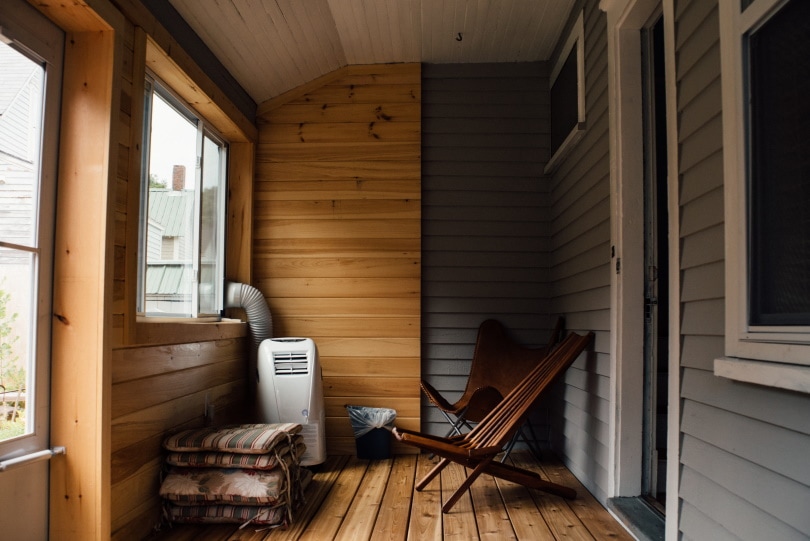How to Test Indoor Air Quality – 4 Possible Ways
-
Kristin Hitchcock
- Last updated:

We hear a lot about outdoor air pollutants, and it isn’t uncommon to assume that outdoor air is simply very dirty. However, the truth is that indoor air is often at least five times dirtier than outdoor air. In some cases, it can even be 100 times higher in some pollutants than the air found outside!
For this reason, there are many ways out there that can help clean the air in your home. For instance, indoor plants are often touted as an easy way to cleanse the air. There are also commercial purifiers that can remove pollutants.
But how can you be certain that these methods are actually working? To figure out how polluted your indoor air is, you’ll need to test indoor air quality. Luckily, there are a few different ways that you can do this, too.
 How to Test Indoor Air Quality (4 Ways)
How to Test Indoor Air Quality (4 Ways)
1. Get an Air-Quality Monitor

Also called an IAQ, these monitors are specifically made to determine air quality. While these products are the best way to accurately determine indoor air quality, we wouldn’t be surprised if you have never heard of them before. Still, there are actually a few different models available.
Basically, IAQs are small, electronic devices that test the air quality of your home and report it. Exactly what they test varies. Most test for chemicals and particulate matter. However, others can also check for carbon dioxide, carbon monoxide, and formaldehyde.
Usually, these devices are around $100 for a cheaper option. High-end models that test for nearly anything are around $300. Of course, there are many models in the middle that only test for certain things.
2. Use a Mold-Testing Kit
There are a few different mold-testing kits out there that can determine how much mold is in your home. Most IAQs will not report on mold, so this is a separate add-on we recommend. Or, if you have a mold allergy, you may only need to test for mold spores.
Everyone has mold in their home at some point, and most have a little bit at all times. However, large amounts of mold spores can be dangerous pollutants.
You can find mold tests at many hardware stores that are cheap and easy to use—but also pretty much useless. Usually, these tests involve leaving a dish out for some time to see if it catches any mold spores. If mold starts growing, then your house has mold. If it doesn’t, then the test will usually claim that your home is clean.
However, these tests are rarely accurate because you place them in a single spot. Plus, everyone’s house has a little bit of mold. If mold starts growing on the dish, you may have more than the recommended amount—or you could just be unlucky.
Your best bet is to call a professional and have them test your home. While this usually isn’t necessary for everyone, it can be useful for those with allergies or sensitivities to mold. If you have random allergy symptoms, think you see mold, have leaking water, or smell a musty odor, call a professional. If you’ve been in your home for more than ten years and have never had it tested, call a professional.
- Related Read: 10 Black Mold Myths And Misconceptions
3. Get a Carbon Monoxide Alarm

Easily the most dangerous contaminant for indoor air is carbon monoxide. Most air quality problems will have gradual health effects, but carbon monoxide will kill you quickly. It is typically referred to as a “silent killer” because it is tasteless, odorless, and colorless. In other words, there is no way to tell it is there.
Usually, the most common source of carbon monoxide is fuel combustion. Therefore, anything that burns gas can potentially release carbon monoxide into the air. For instance, gas dryers, gas stoves, and gas furnaces are all the most common sources of carbon monoxide poisoning.
However, even if you don’t have one of these appliances, you may still want to install one of these monitors. There are many other appliances that burn gas and can therefore cause carbon monoxide leaks. For instance, many homes have hot water heaters, which usually burn gas.
These detectors are typically battery-powered as it allows you to install them on the ceiling. Carbon monoxide is lighter than air, so it goes up. Therefore, these detectors are best when they can be installed on the ceiling.
Luckily, these detectors are quite inexpensive. They only cost about $8 a unit. Usually, you install these above your sleeping area, avoiding the corners where possible. Setting them up is often extremely easy—all you have to do is take them out of the box and turn them on.
4. Check for Radon
Radon will not kill you quickly as carbon monoxide does, but it can be dangerous over the long term. In fact, many lung cancer deaths are related to radon. Radon enters homes in many different ways. For instance, it can enter from the earth through cracks in your foundation and the areas around pipes. It usually comes from the soil, so it tends to build up in the basement and other areas of your home.
Basically, it can enter anywhere that your home is exposed to dirt—which is typically a lot of places.
Luckily, you can purchase a radon testing kit at many different home improvement stores. They are not terribly difficult to do and all the directions should be included. Usually, you have to allow the test to sit for a few days for the most accurate result.
If radon is a particular problem where you live, you can order an electric radon test. These tests work like carbon monoxide testers and continuously check for high levels of radon. However, they can be expensive, with many models being more than $150.
 Conclusion
Conclusion
There are many contaminants that can harm your air quality and cause health problems. Many of these contaminants affect your health over the long term, leading to cancer and other health problems down the line. However, others can kill you outright, like carbon monoxide.
Sadly, no one test can check for everything. Instead, you’ll need to identify what contaminants are most common in your area (or most harmful) and check for those. An IAQ machine is a great place to start since it tests for a little bit of everything.
You may also want to invest in a carbon monoxide tester since this gas is extremely dangerous.
Featured Image Credit: tianya1223, Pixabay
Contents
 How to Test Indoor Air Quality (4 Ways)
How to Test Indoor Air Quality (4 Ways)